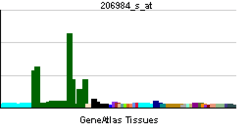RIT2
| View/Edit Human | View/Edit Mouse |
GTP-binding protein Rit2 is a protein that in humans is encoded by the RIT2 gene.[4][5][6]
RIN belongs to the RAS (HRAS; MIM 190020) superfamily of small GTPases (Shao et al., 1999).[supplied by OMIM][6]
RIT2 has been associated with Parkinson's disease in two large genetic studies.[7][8] An gene expression study of postmortem brain has suggested RIT2 interacts with interferon-γ signalling.[9]
Interactions
RIT2 has been shown to interact with POU4F1.[10]
References
- ↑ "Diseases that are genetically associated with RIT2 view/edit references on wikidata".
- ↑ "Human PubMed Reference:".
- ↑ "Mouse PubMed Reference:".
- ↑ Lee CH, Della NG, Chew CE, Zack DJ (Nov 1996). "Rin, a neuron-specific and calmodulin-binding small G-protein, and Rit define a novel subfamily of ras proteins". J Neurosci. 16 (21): 6784–94. PMID 8824319.
- ↑ Wes PD, Yu M, Montell C (Jan 1997). "RIC, a calmodulin-binding Ras-like GTPase". EMBO J. 15 (21): 5839–48. PMC 452332
 . PMID 8918462.
. PMID 8918462. - 1 2 "Entrez Gene: RIT2 Ras-like without CAAX 2".
- ↑ Pankratz, N; Beecham, G. W.; Destefano, A. L.; Dawson, T. M.; Doheny, K. F.; Factor, S. A.; Hamza, T. H.; Hung, A. Y.; Hyman, B. T.; Ivinson, A. J.; Krainc, D; Latourelle, J. C.; Clark, L. N.; Marder, K; Martin, E. R.; Mayeux, R; Ross, O. A.; Scherzer, C. R.; Simon, D. K.; Tanner, C; Vance, J. M.; Wszolek, Z. K.; Zabetian, C. P.; Myers, R. H.; Payami, H; Scott, W. K.; Foroud, T; Pd Gwas, Consortium (2012). "Meta-analysis of Parkinson's disease: Identification of a novel locus, RIT2". Annals of Neurology. 71 (3): 370–84. doi:10.1002/ana.22687. PMC 3354734
 . PMID 22451204.
. PMID 22451204. - ↑ Nalls, M. A.; Pankratz, N; Lill, C. M.; Do, C. B.; Hernandez, D. G.; Saad, M; Destefano, A. L.; Kara, E; Bras, J; Sharma, M; Schulte, C; Keller, M. F.; Arepalli, S; Letson, C; Edsall, C; Stefansson, H; Liu, X; Pliner, H; Lee, J. H.; Cheng, R; International Parkinson's Disease Genomics Consortium (IPDGC); Parkinson's Study Group (PSG) Parkinson's Research: The Organized GENetics Initiative (PROGENI); Hadjigeorgiou, Georgios M; Bis, Joshua C; NeuroGenetics Research Consortium (NGRC); Hussman Institute of Human Genomics (HIHG); Ashkenazi Jewish Dataset Investigator; Cohorts for Health Aging Research in Genetic Epidemiology (CHARGE); North American Brain Expression Consortium (NABEC); et al. (2014). "Large-scale meta-analysis of genome-wide association data identifies six new risk loci for Parkinson's disease". Nature Genetics. 46 (9): 989–93. doi:10.1038/ng.3043. PMC 4146673
 . PMID 25064009.
. PMID 25064009. - ↑ Liscovitch, N; French, L (2014). "Differential Co-Expression between α-Synuclein and IFN-γ Signaling Genes across Development and in Parkinson's Disease". PLoS ONE. 9 (12): e115029. doi:10.1371/journal.pone.0115029. PMC 4262449
 . PMID 25493648.
. PMID 25493648. - ↑ Calissano, M; Latchman D S (Aug 2003). "Functional interaction between the small GTP-binding protein Rin and the N-terminal of Brn-3a transcription factor". Oncogene. England. 22 (35): 5408–14. doi:10.1038/sj.onc.1206635. ISSN 0950-9232. PMID 12934100.
Further reading
- Shao H, Kadono-Okuda K, Finlin BS, Andres DA (1999). "Biochemical characterization of the Ras-related GTPases Rit and Rin.". Arch. Biochem. Biophys. 371 (2): 207–19. doi:10.1006/abbi.1999.1448. PMID 10545207.
- Hoshino M, Nakamura S (2002). "The Ras-like small GTP-binding protein Rin is activated by growth factor stimulation.". Biochem. Biophys. Res. Commun. 295 (3): 651–6. doi:10.1016/S0006-291X(02)00731-3. PMID 12099688.
- Strausberg RL, Feingold EA, Grouse LH, et al. (2003). "Generation and initial analysis of more than 15,000 full-length human and mouse cDNA sequences.". Proc. Natl. Acad. Sci. U.S.A. 99 (26): 16899–903. doi:10.1073/pnas.242603899. PMC 139241
 . PMID 12477932.
. PMID 12477932. - Calissano M, Latchman DS (2003). "Functional interaction between the small GTP-binding protein Rin and the N-terminal of Brn-3a transcription factor.". Oncogene. 22 (35): 5408–14. doi:10.1038/sj.onc.1206635. PMID 12934100.
- Gerhard DS, Wagner L, Feingold EA, et al. (2004). "The status, quality, and expansion of the NIH full-length cDNA project: the Mammalian Gene Collection (MGC).". Genome Res. 14 (10B): 2121–7. doi:10.1101/gr.2596504. PMC 528928
 . PMID 15489334.
. PMID 15489334. - Hartwig C, Veske A, Krejcova S, et al. (2006). "Plexin B3 promotes neurite outgrowth, interacts homophilically, and interacts with Rin.". BMC neuroscience. 6: 53. doi:10.1186/1471-2202-6-53. PMC 1215486
 . PMID 16122393.
. PMID 16122393. - Shi GX, Han J, Andres DA (2006). "Rin GTPase couples nerve growth factor signaling to p38 and b-Raf/ERK pathways to promote neuronal differentiation.". J. Biol. Chem. 280 (45): 37599–609. doi:10.1074/jbc.M507364200. PMID 16157584.
- Rual JF, Venkatesan K, Hao T, et al. (2005). "Towards a proteome-scale map of the human protein-protein interaction network.". Nature. 437 (7062): 1173–8. doi:10.1038/nature04209. PMID 16189514.
This article is issued from Wikipedia - version of the 6/5/2016. The text is available under the Creative Commons Attribution/Share Alike but additional terms may apply for the media files.
